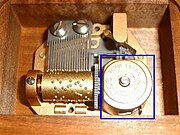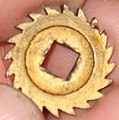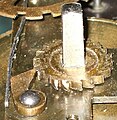Barrel
A barrel is part of a watch . This is a housing for receiving a coil spring , with the clock driven is. This is usually drum-shaped and usually closed with a lid.
properties
There are a number of uses for barrels. Very common applications are clockworks with a spring mechanism and music boxes with a spring mechanism.
The main advantages of the barrel are:
- easy assembly of the work / music box
- easy and less dangerous dismantling of the work / music box, as the spring does not press against other parts
- less risk if someone handles the work inappropriately
- reduced risk of injury if the spring breaks
- hardly any pollution of the spring
- Possibility to grease or oil the nib
- no stress on the housing due to spring pressure
Based on Hermann Brinkmann, there are different versions of spring barrels:
- fixed barrel (still widely used in music boxes today)
- revolving barrel with toothing (with a special form of the "flying barrel")
- Split barrel with teeth on the barrel itself and on the parallel gear
- Barrel with snail
It is fundamental with every conventional mainspring for watches that the spring consists of a flat band that has been prepared for attachment at both ends and one end is hooked into a hook of the so-called spring core (or barrel core ) and wrapped around the spring core. The spring core is part of a shaft or axle or is permanently connected to it. The spring can be rolled up with the help of a spring winder and inserted into the barrel.
Movement with freely pulling spring or without barrel (for comparison)
- Construction: The spring is attached at one end to a pillar of the work and at the other end it is hooked into a small hook on the spring core (part of the shaft). A ratchet wheel is fixedly attached to the shaft with the spring and a toothed wheel ( spring wheel ) is rotatably mounted, which is prevented by a pawl from turning loosely in one of the two directions, while the other direction of rotation is not restricted. When the tension spring is pulled up , the pawl releases the direction of rotation of the elevator and the shaft rotates against the gear. When the work is running, the pawl locks and the gear wheel rotates at exactly the same speed as the shaft.
- Special features: What is striking about the movement without the barrel is that the springs protrude clearly beyond the movement in the "relaxed" state and various parts, etc. within the movement. a. subject several gears to strong lateral forces. For the watchmaker, this has the disadvantage that when opening the movement, many parts are thrown out of the movement at high speed in some cases if he has not taken appropriate protective measures beforehand. Another disadvantage of this simple and inexpensive solution is that while the spring is being wound up, the work is completely relieved and possibly moved slightly in the opposite direction. The advantage is the inexpensive production. From a historical point of view, the great freedom of the mainspring and the longer running time of early clocks with a "freely pulling spring" instead of barrels was an advantage. Today the design of watch springs and barrels is so advanced that the advantages of the barrel outweigh the disadvantages.
Music box with a fixed barrel
- Construction: The outer end of the spring is hooked into the barrel (visible in the photo in the lower area of the barrel) and the other end is hooked into a small hook on the spring core (part of the shaft). The barrel is firmly connected to the base plate of the music box or to the board of the clockwork (e.g. screwed on). The spring wheel with pawl, ratchet wheel and spring core is constructed in the same way as in clockworks without a barrel.
- Special features: While the spring is being wound up, the movement is completely relieved and possibly moved slightly in the opposite direction, which is not a disadvantage for music boxes. The fixed barrel offers excellent protection against parts of the spring jumping out in the event of a break in the spring or injuries caused by careless reaching into the spring. This means that the fixed barrel is ideally suited for use in music boxes. The fixed barrel is rarely used for watch movements today, as the lower costs compared to a rotating barrel are negligible.
Revolving barrel
- Structure: A ratchet wheel with a pawl sits on the winding shaft and prevents the energy of the spring from disappearing immediately when the winding key is released. (Can be seen in the photo of the ratchet: the ratchet wheel has two defective teeth and the spring does not press the pawl sufficiently against the ratchet wheel.) Inside the barrel there is a shaft with the spring core. The shaft has a bearing journal at the rear and the elevator square at the front. The spring itself has been wrapped around the spring core (which sits on the shaft) before being pushed into the barrel. The inner as well as the outer end of the spring has a breakthrough ("hole") which is used so that a mandrel in the shaft and a mandrel in the outside of the barrel can secure the spring ends against slipping. This results in the necessity that every turn that was made with the winding square is later reproduced in an analog movement of the circumference of the barrel. Until this happens, the spring remains under tension. The forces involved are usually dramatically underestimated. The opening of clockworks with springs that are not relaxed or the opening of barrels or the removal of springs from barrels should only be carried out under expert guidance and with suitable tools!
- Special features: The revolving barrel differs further from the previous solutions: It rotates as the movement runs. The spring force acts on the movement unchanged during the winding process, so that even very slow winding does not bring the movement to a standstill. The barrel can also be easily removed from the factory and used when it is relaxed. The revolving barrel is a very common solution today that offers a lot of security, even if the spring breaks, without requiring more space.
Flying barrel
The flying barrel is a special design of the rotating barrel.
- Construction: The barrel shaft is only held on one side of the flying barrel. To prevent the shaft and barrel from falling out of the factory, a so-called cap is screwed onto the side of the ratchet wheel , which also holds the shaft with the ratchet wheel in position.
- Special features: The flying barrel was used almost exclusively in pocket watches with a winding key to save overall height. On the free or flying end of the shaft there is a square on which the watch can be wound.
Split barrel
- Construction: In alarm clocks with only one winding for movement and alarm mechanism together or in some special clockworks, the barrel is divided, as in the picture above. On the left you can see a revolving barrel that has no cover. It drives the movement. Immediately after this barrel, on the right, there is a spring wheel (gear) with a pawl and ratchet wheel, which drives the alarm mechanism. In this solution, both ends of the spring are used to drive a work part. This barrel has on the outside and in the picture on the left the structure of the barrel with toothing and inside and in the picture on the right the structure of a gear for a fixed barrel or for a movement without a barrel.
- Special features: The distinct advantage of this solution is that two parts of the movement can be driven with one spring and only one spring has to be wound. Disadvantages are that a work part is not driven during the winding process and that the spring naturally also has to generate the energy for both work parts. Both disadvantages are of very little importance for alarm clocks, but for the rare works where z. B. a clock with Westminster chime was realized with only two mainspring, clearly noticeable by the very high force when winding the combined striking mechanism.
All the solutions presented so far have the disadvantage that the spring force does not act unchanged on the movement, but is much stronger when the spring is fully wound than when the spring has almost expired. If the escapement of the movement cannot largely compensate for this disadvantage, only the solution with a worm can help:
Barrel with snail
- Construction: The barrel with a worm is the most complicated solution of all. Here the spring is housed in the barrel. The "shaft" of the barrel or, more precisely, the axis of the barrel is completely still or fixed during the winding process or the process of the movement. In both processes, only the barrel is turned against the axis. This is done using a cable pull (see photos) (often a tear-resistant steel band for replicas) or a chain hoist. The rope is attached to one point of the cylindrical barrel and the other end to the end of the screw with the largest diameter. The worm sits on a square shaft which is turned in one direction by the winding key to wind the movement. The pawl, which sits on the gear next to the worm, releases the movement of the worm shaft relative to the gear. During the winding process, the rope is unwound from the barrel and wound onto the worm. The further the spring is tensioned by the unwinding of the rope from the barrel, the greater the force on the rope, since the spring is increasingly tensioned. This is compensated for by the decreasing diameter of the screw as the rope increasingly wound onto the screw.
Since the spring still has to exert force on the movement even when it has expired, it is necessary that it is pretensioned. This is done via a ratchet wheel on the axis of the barrel with a pawl mounted on the factory board. The associated square is only accessible when the movement is uncovered and is only used when assembling the movement or the spring is relaxed before the movement is dismantled.
- Special features: This method ensures that the torque with which the worm gear drives the work remains almost constant, regardless of whether the spring is fully wound or almost run down.
The disadvantage is that the work is completely relieved and possibly moved slightly in the opposite direction while the spring is being pulled up. Since the duration of the winding up is far below the duration of the process, the advantages clearly outweigh the disadvantages. The space required for this solution is a little twice as large as with a rotating barrel. The spring barrel with a worm was mainly used in high-quality watches in the past. Today, the difference in the spring tension in high-quality watches is neutralized by escapements that do not lead to relevant differences in the oscillation frequency with different driving forces.
See also
Web links / sources / footnotes
- ^ Helmut Kahlert , Richard Mühe , Gisbert L. Brunner : Wristwatches: 100 years of development history. Callwey, Munich 1983; 5th edition, ibid. 1996, ISBN 3-7667-1241-1 , p. 48.
- ^ Hermann Brinkmann: Introduction to the watchmaking apprenticeship. Wilhelm Knapp Verlag, 1980









